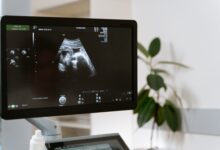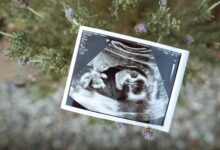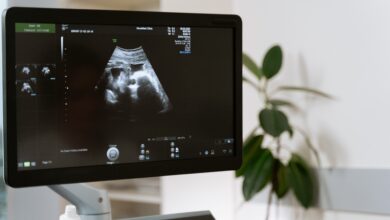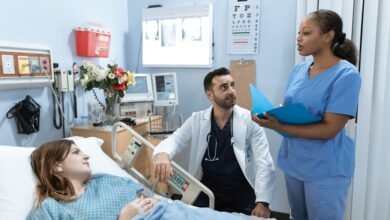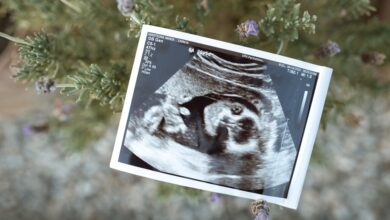
3 weeks pregnant: where is the baby?
During this 3rd week of pregnancy (3 SG), ie the 5th week of amenorrhea (5 WA), the development of the egg accelerates. Over successive cell divisions, the egg grows and is now 1.5 mm. It has an ovoid shape: the wide end corresponds to the cephalic region, the narrow one to the caudal region (lower part of the body).
An essential process then begins during this first month of pregnancy : cell differentiation. It is from each cell of this period that all the other cells of the baby will derive. From the 17th day, the embryonic disc begins to thicken at its midline, along the head-tail axis. This is the primitive streak that will lengthen and take up about half the length of the embryo . From this primitive streak will differentiate a new sheet of cells. This is gastrulation: from didermic (two layers of cells), the embryonic disc becomes tridermic. It is now composed of three layers of cells, at the origin of all the baby’s organs:
· the inner layer will give the organs of the digestive system (intestinal, stomach, bladder, liver, pancreas) and the respiratory system (lungs);
· from the middle layer are formed the skeleton (with the exception of the skull), the muscles, the sexual glands (testicles or ovaries), the heart, the vessels and the entire circulatory system;
· the external layer is at the origin of the nervous system, the organs of the senses, the skin, the nails, hair and hair.
Some organs come from two layers. This is particularly the case of the brain. On the 19th day, one of the ends of the primitive streak presents a swollen part towards which various cells have migrated: this is the outline of the brain, from which the entire central nervous system will be built during the process called neurulation. On the back of the embryo, a kind of gutter is hollowed out then forms a tube around which protuberances appear, the somites. This is the outline of the spine.
The placenta continues to develop from the trophoblast, whose cells multiply and branch to form the villi. Between these villi, lacunae filled with maternal blood continue to fuse together.
Last but not least, a big change: at the end of the third week of pregnancy, the embryo has a beating heart, admittedly gently (about 40 beats/minute), but beating. This heart, which is still only a cardiac outline made up of two tubes, was formed from the primitive streak between the 19th and 21st days, when the embryo is almost 3 weeks old.
Where is the mother’s body at 3 weeks of pregnancy (5 SA)?
It is during the 5th week of amenorrhea (3 SG) that the first sign of pregnancy finally appears: late menstruation.
At the same time, other sings may appear under the effect of the hormonal climate of pregnancy, and more specifically the hCG hormone and progesterone:
- a swollen and tense chest;
- tiredness ;
- a frequent urge to urinate;
- morning sickness;
- some irritability.
Pregnancy is however still invisible during the 1st trimester.
3 weeks pregnant: how to adapt?
Although symptoms can be felt in subtle ways when a woman is 3 weeks pregnant, new lifestyle habits need to be adopted . This allows the fetus to develop in good conditions. The mother-to-be must take her needs into consideration, in particular taking care of herself and avoiding stress. Fatigue and anxiety can, in fact, be harmful for the 3 week old embryo. To remedy this, the pregnant woman can take naps if she is sleepy during the day. Also, relaxation exercises, such as meditation or a calming activity, can help you feel good and calm. Practicing a gentle physical activity is also recommended, such as walking or swimming. A medical opinion can be requested from his doctor.
Which foods to favor at 3 weeks of pregnancy (5 SA)?
The in-vitro baby will be able to feed via the placenta. Food is therefore very important throughout pregnancy, with foods to be preferred according to the different stages. At 5 weeks of amenorrhea (3 SG), folic acid is essential for the proper development of the baby. It is vitamin B9, essential for cell multiplication. Folic acid also actively participates in the proper development of the brain. Indeed, at 3 weeks of pregnancy (5 SA), the formation of the brain of the embryo has already begun.
Vitamin B9 is not made by the body. It is therefore necessary to bring it, even before conception and then throughout the first month of pregnancy, and even beyond the second month of pregnancy. The goal is to avoid a deficiency that could weaken the growth of the fetus . This can be done through a supplement or through food. Some foods are rich in folic acid. This is the case with green vegetables (spinach, cabbage, beans, etc.). Legumes (lentils, peas, beans, etc.) also contain it. Finally, certain fruits, such as melon or orange, can prevent possible folic acid deficiencies.
When pregnant, it is important to eat balanced meals and not to give in too much on sweets or processed foods. These have no nutritional benefits and facilitate weight gain in the future mother. It is recommended to drink between 1.5 L and 2 L of water daily because the blood volume of pregnant women increases. In addition, staying well hydrated provides minerals and prevents urinary tract infections or constipation.
What not to forget at 5 SA
From the first day of late menstruation , it is possible to do a pregnancy test, preferably on the morning urine which is more concentrated. The test is reliable at 3 weeks of pregnancy (5 SA).
A blood test will then be necessary to confirm the pregnancy. It is advisable to quickly make an appointment with your gynecologist or a midwife in order to plan the first mandatory prenatal visit. This first official visit can be carried out until the end of the 3rd month of pregnancy (15 SA), but it is preferable to do it quite early. The first prenatal examination includes various serologies (toxoplasmosis in particular) for which it is important to know the results in order, if necessary, to take the necessary precautions on a daily basis.
Advice
During the first weeks of pregnancy, organogenesis takes place, a stage during which all the baby’s organs are put in place. It is therefore a high-risk period, because exposure to certain substances can interfere with this process. As soon as the pregnancy is confirmed, it is therefore advisable to stop all risky practices: smoking, consumption of alcohol, drugs, taking medication without medical advice, exposure to X-rays. Various aids exist, in particular for the smoking cessation. Do not hesitate to talk about it with your gynecologist, a midwife or your doctor.
Bleeding is frequent at the beginning, during the 1st month of pregnancy, but fortunately does not systematically signal a miscarriage. However, it is advisable to consult in order to check the good progress of the pregnancy. Similarly, any pelvic pain, especially sharp ones, must be the subject of a consultation in order to rule out a possible ectopic pregnancy.

